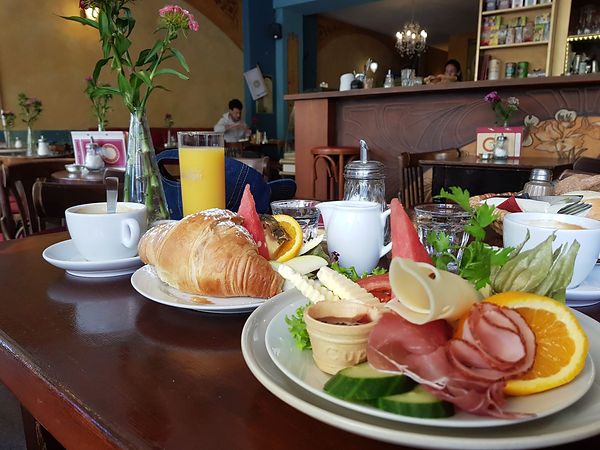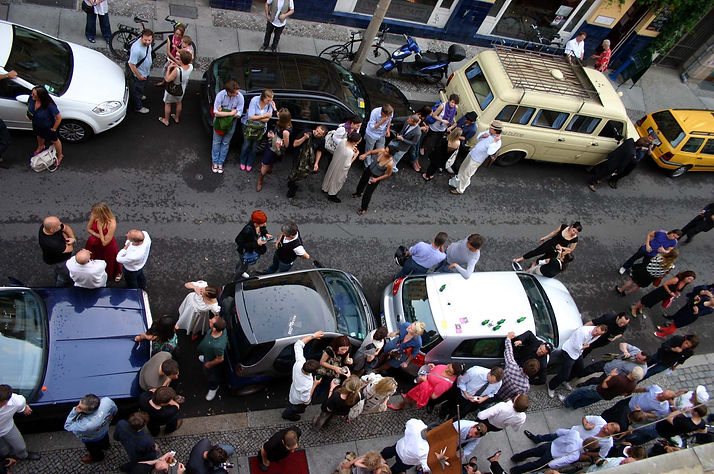TRAVEL IMPRESSIONS OF AN ART AND HISTORY LOVER
and my experiences as a teacher in China
UMGEBUNGSENTDECKER

Berlin


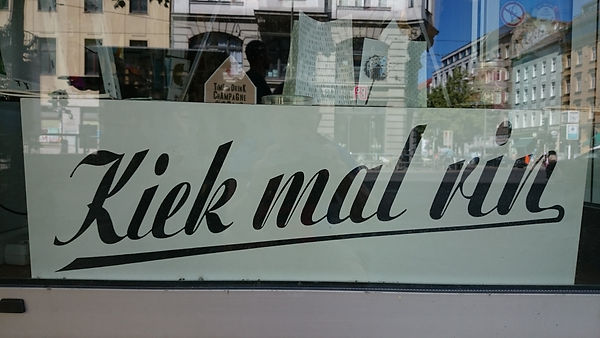
1930
Ich bin neun Jahre alt, als ich nach Berlin komme und aus dem Zug steige: Anhalter Bahnhof, auf großen Schildern. Menschen, Dampf, Zischen, Eisenbahngeruch, Verkäufer mit Wurstkesseln. Händler bieten Zeitungen an und Sitzkissen. Abfahrt in Richtung Basel, Halle, Karlsbad, Prag, Wien, Leipzig, München, Rom.
Zur Zeit der Olympischen Spiele in Berlin. Ich entsinne mich an zweierlei: Jemand aus der Verwandtschaft fuhr ab. Wir brachten ihn hin und ich sah zehnjährige amerikanische Mädchen auf dem Bahnsteig, sie trugen elegante Hüte und waren wie Damen gekleidet, während ich ein Junge in kurzen Hosen war. Als es den Anhalter Bahnhof noch gab, ging ich noch zur Schule und lernte: Er heißt so, weil die Züge dort anhalten.
Hans Knobloch: Der angehaltene Bahnhof


1920
Romanisch wie die Kirche waren die neuen Gebäude am Auguste-Viktoria-Platz. So hatte es der Kaiser gewollt und so hatte sie Franz Schwechten gebaut.
Eines dieser beiden Häuser, die im romanischen Stil vor dem Portal und dem Chor der Gedächtniskirche entstanden waren, beherbergte seit seiner Fertigstellung 1900 ein Café-Restaurant: Groß und hässlich soll es gewesen sein, das Romanische Café, im Innern düster. „Es war ein Anachronismus, eine architektonische Scheußlichkeit ... Der Kaffee war schlecht, der Kuchen alt, die Eier im Glas teuer ...“ (Hans Tasiemka).
Es war ein neuer metropolitaner Typus des Künstler-Cafés entstanden:
Seccessionisten, Expressionisten und Dadaisten hatten hier ihre angestam-mten Tische, Literaten und Regisseure, Kunsthändler und Maler, Schauspieler und Bühnenbildner.
Text on the Romanisches Café: from: Berlin, Berlin, the exhibition on the history of the city, general publisher: Berliner Festspiele GmbH on behalf of the Berlin Senate for the 750th anniversary of Berlin in 1987.
1930
Den Eingang zur Wassertorstraße bildete ein großer steinerner Torbogen, ein Stück Alt-Berlin, mit Hammer und Sichel beschmiert und beklebt mit angerissenen Versteigerungsanzeigen und Steckbriefen. Es war eine düstere, armselige Straße mit Kopfsteinpflaster, auf der es von verheulten Kindern wimmelte. Burschen in Wollsweatern beschrieben auf ihren Rennrädern
kunstvoll ausbalancierte Kreise und riefen Mädchen an, die mit Milchtöpfen vorübergingen. Der Gehsteig war mit Kreidestrichen für das Hüpfspiel „Himmel und Erde“ bemalt. Am Ende der Straße stand riesengroß, beängstigend spitz und rot, eine Kirche.
Christopher Isherwood: Leb wohl, Berlin



1930
Um acht Uhr abends werden die Haustüren zugemacht. Die Kinder bekommen ihr Abendbrot. Die Geschäfte sind geschlossen. Über der
Nachtglocke des kleinen Hotels an der Ecke, wo man Zimmer stundenweise mieten kann, wird das Leuchtschild eingeschaltet. Und bald hebt das Pfeifen an. Junge Männer rufen ihre Mädchen. Sie stehen unten in der Kälte und pfeifen hinauf zu den hellen Fenstern warmer Zimmer, in denen die Betten für die Nacht schon gerichtet sind. Sie möchten eingelassen werden. Ihre Pfiffe hallen wider im dunklen Schacht der Straße, lüstern, einsam und traurig.
Des Pfeifens wegen bin ich abends nicht gern zu Hause. Es erinnert mich daran, dass ich allein in einer fremden Stadt bin, weit weg von daheim.
Christopher Isherwood: Leb wohl, Berlin

.jpg)
.jpg)

1930
Wenn ich dann in der Dunkelheit im Bett lag, in meinem kleinen Winkel
innerhalb des riesigen Menschenkäfigs, den die Mietshäuser bildeten, konnte ich mit unheimlicher Schärfe jeden Ton vom Hof herauf hören. Der Schacht des Hofes muss wie ein Grammophontrichter gewirkt haben. Da ging jemand die Treppe hinunter: Wahrscheinlich unser Nachbar, Herr Müller, der
Nachtschicht bei der Eisenbahn hatte. Ich lauschte seinen Schritten, die mit
jedem Stockwerk schwächer wurden, nun hörte ich deutlich, wie sie auf dem
klebrig, nassen Pflaster den Hof überquerten. Wenn ich angespannt lauschte, hörte ich - vielleicht auch nur in der Einbildung - das Rasseln des Schlüssels im Schloss der großen Tür zur Straße. Einen Augenblick später schloss die Tür sich mit einem tiefen, hohlen Laut. Und nun bekam im Nebenzimmer Frau Nowak einen Hustenanfall. In der darauffolgenden Stille krachte Lothars Bett, der sich umdrehte und dabei im Schlaf undeutlich drohende Laute von sich gab. Irgendwo auf der anderen Seite des Hofes begann ein kleines Kind zu schreien, ein Fenster wurde heftig zugeworfen und irgendwo, in den tiefsten Tiefen des Hauses schlug etwas sehr Schweres dumpf gegen eine Wand.
Fremdartig mutete das an, geheimnisvoll und unheimlich, als schliefe man
allein draußen im Dschungel.
Christopher Isherwood: Leb wohl, Berlin
The socket wrench
also: Berlin key, double key; English : Berlin key is a key with two identical beards . After the lock has been unlocked, the key must be pushed through the lock in order to pull it out of the lock on the other side with a twist, which locks the lock again. The pass-through key therefore forces the user of a passage door, which is to be kept locked, to close it again immediately after going through or to leave his key in the door. Such door locks with compulsory locking were for the front doors of Berliners Tenements with backyards are the norm. In this way one prevented a gathering of workers who could no longer mobilize for street fights because one could not get into the backyards.
Nowadays the socket key is only used sporadically in old building areas with corresponding doors and gate entrances, but is now a popular Berlin souvenir.
according to Wikipedia
1930
Bernhard hatte ich lange nicht gesehen. Ich war daher ganz überrascht, eines
Morgens seine Stimme am Telefon zu hören. Er wollte wissen, ob ich abends
mit ihm aufs Land fahren und dort übernachten wolle. Das klang sehr
geheimnisvoll und Bernhard lachte nur, als ich herausbekommen wollte, wohin
es ginge und was er damit beabsichtigte. Er kam gegen acht in einem großen geschlossenen Wagen mit Chauffeur. Der Wagen rollte über die Avus in die gewaltige Dunkelheit der winterlichen Landschaft hinein. Riesige Rückstrahlschilder leuchteten kurz im Licht unserer Scheinwerfer auf und erloschen wie abgebrannte Zündhölzer. Schon lag Berlin hinter uns, am Himmel ein rötlicher Schein, der rasch hinter dem dichter werdenden Kiefernwald verschwand.
Das schmale Scheinwerferlicht des Funkturms kreiste durch die Nacht. Die
gerade, schwarze Straße brauste uns ungestüm entgegen, als sollten wir sie verschlingen. "Na schön, ich will es Ihnen sagen ... Wir fahren zu einem Haus am Wannsee, das meinem Vater gehörte. In England nennen Sie so etwas ein Landhaus."

Der Wagen bog rechts ab auf eine Straße, die zwischen Baumsilhouetten hinführte. Man spürte die Nähe des großen Sees der jetzt nicht sichtbar, linker Hand hinter dem Waldgelände lag. Ich hatte kaum bemerkt, dass die Straße in einen Privatweg eingemündet war: Wir hielten vor einer großen Villa.
Nach dem Essen gingen wir in den windigen, dunklen Garten hinaus. Starker Wind wehte vom Wasser her durch die Bäume. Ich folgte Bernhard über Steinstufen zu einem Bootssteg hinunter. Der dunkle See war sehr bewegt und hinten, in der Richtung von Potsdam, schimmerte eine Reihe von Bogenlaternen wie ein Kometenschweif im schwarzen Wasser. Am Geländer klapperte eine kahle Gaslaterne im Wind und unter uns schlugen die Wellen geheimnisvoll sanft und nass an die unsichtbaren Steine.

founded in 1913
everything survives: Empire, Weimar Republic, Third Reich, GDR, FRG
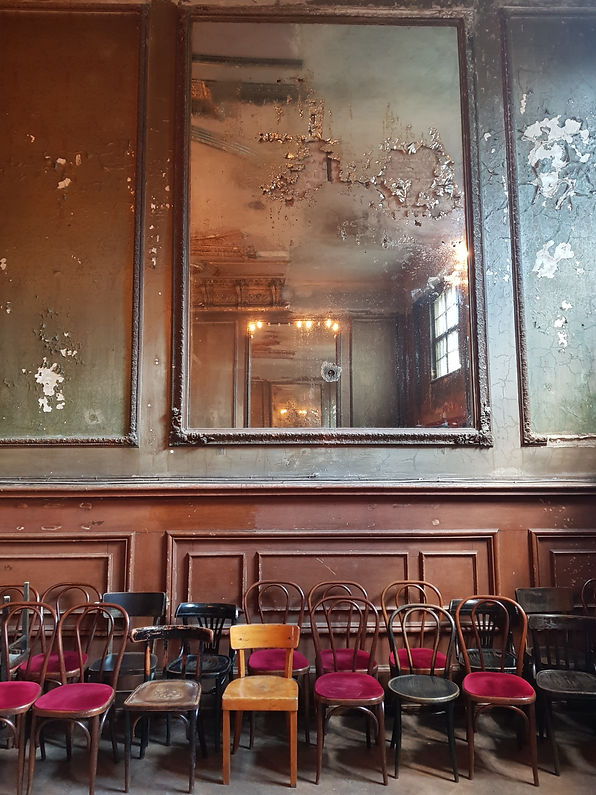

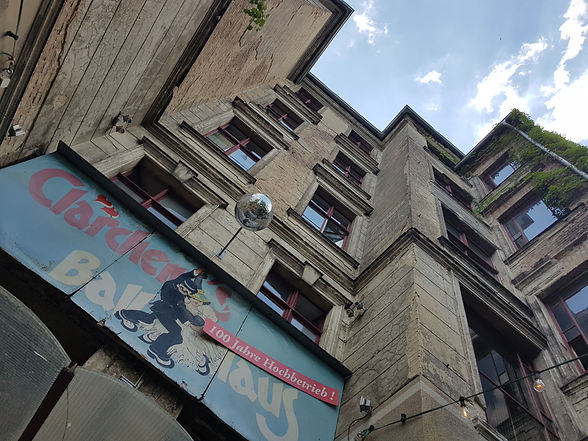
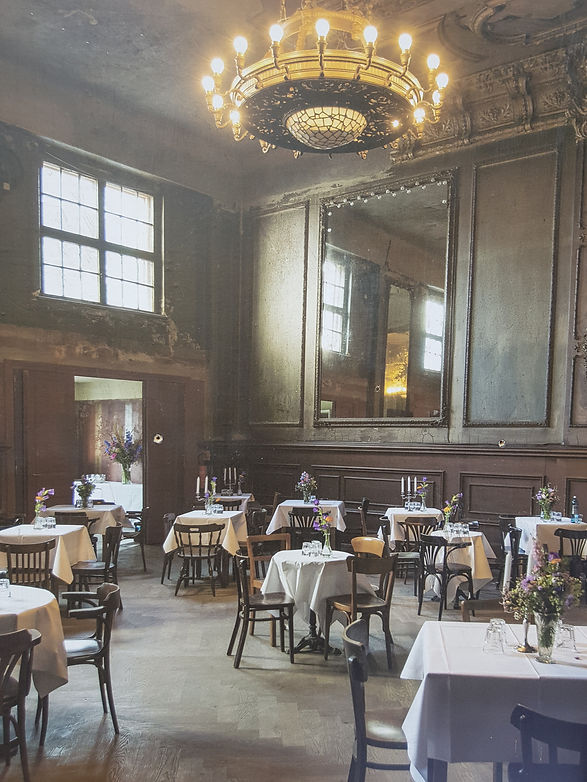



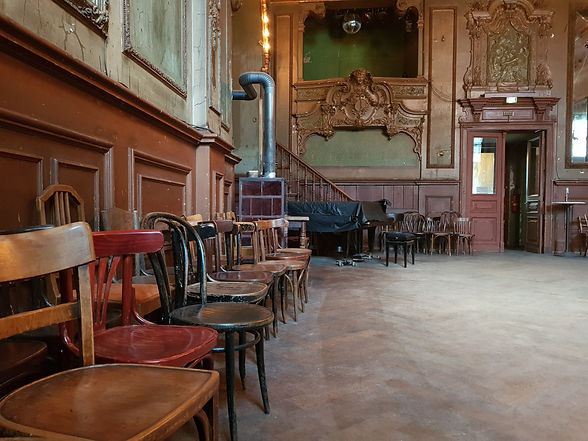
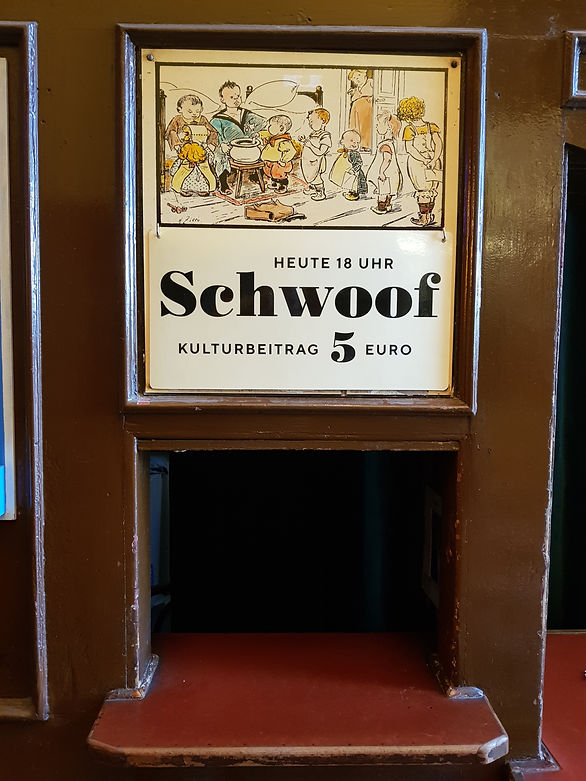


METROPOLIS
the fastest city in the world

"You cross Potsdamer Platz, Spittelmarkt, Alexanderplatz, the street at Stettiner Bahnhof, Wedding and the like. There you notice the gigantic movement, the scurrying, scurrying and whizzing, wave after wave chasing up and fleeing - maddening Tempo! The heart of the Reich, this Berlin, pulsates with life!
4 million people in operation, a fifteenth of the German people at rapid pace! And while everything hurries and pushes below, the engine sings from the air! Great sight: Tempelhof Airport! "
It is a breathless language full of staccato, pathos, emphasis, expressionism, war and sports reporting, to the rhythm of locomotives and rotary machines, which the graphic institute Otto Elsner chose when it published an advertising brochure for Berlin and itself for the 1929 World Advertising Congress in Berlin .
Modern man was almost as interested in the speed of any event as it was in the masses, noted Werner Sombart in 1920, and those who cannot move around like in flight enjoy the numbers they read about the speeds achieved somewhere. The real "Berlin Tempo" has therefore contributed to the excitement - and disquiet - about the dynamism of Berlin since the days of the German Empire, as did the self-advertisement of the city that it was the fastest in the world. The big city as the focal point of the mass age, the big city as a machine, as a movement system made up of crowds, flows of goods, money and traffic, the new person, the new Berliner of the time after 1918 should find their fulfillment in being carried away by this high-speed progress and possibly speed it up.
Text from: Berlin, Berlin, the exhibition on the history of the city, general publisher: Berliner Festspiele GmbH on behalf of the Berlin Senate for the 750th anniversary of Berlin in 1987.


1980
West Berlin
East Berlin
West Berlin
Berlin - capital of the GDR
Squatter scene
Children's shops
Peace movement
Cold War frontline city
Ruined city

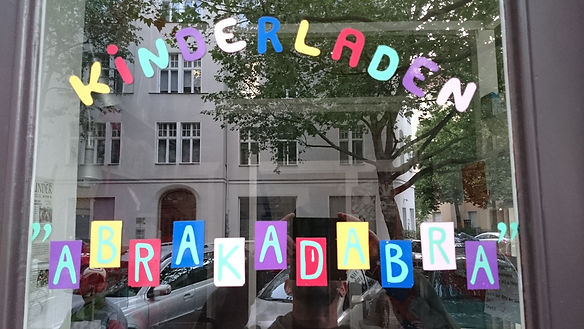
1987
Die klassischen Arbeiterviertel: Wedding, Kreuzberg, Moabit, Schöneberg, Neukölln, Tempelhof. Straßenzüge, die mit der Industrialisierung entstanden sind. Fünfgeschossige Gebäude, links, rechts, vorne, hinten. Hinterhöfe, Lärm, Müll, Arme-Leute-Gegend. Rentner, Ausländer, Studenten, Arbeitslose. Hier haben
viele Wohnungen noch ein Außenklo und Ofenheizung. Eine Kohlenhandlung an jeder Ecke. Im Herbst und Winter sieht man die Kohlenträger schwere Kiepen schleppen. Briketts aus der DDR, der Oma werden sie auf den Balkon gestellt.
Mitten drin die Oasen alternativer Lebensentwürfe. Als der Friseur aufgab, zog hier ein Kinderladen ein. Als der Schuster das Handtuch warf, übernahm die Stadtteilgruppe die Räumlichkeiten. Tante Emmas Laden beherbergt jetzt Bio-Kost, der Gemüseladen ist immer noch ein Gemüseladen, nur wird seit Jahren schon türkisch gesprochen. Die Eckkneipe wurde zum Frühstückskaffee mit morgendlichem Müsli-Angebot. Am Kiosk liegt neben der BZ die tageszeitung, aber auch Cum hurriyet, das Blatt für die deutschen Türken, und
in der ehemaligen Eisenwarenhandlung gibt es jetzt kalt gepresstes Olivenöl und Nicaragua-Kaffee.
Berlin from ideal
Bahnhof Zoo, mein Zug fährt ein
Ich steig aus, froh wieder da zu sein
Zur U-Bahn runter, am Alkohol vorbei
Richtung Kreuzberg, die Fahrt ist frei
Kottbusser Tor, ich spring vom Zug
Zwei Kontrolleure ahnen Betrug
Im Affenzahn die Rolltreppe rauf
Zwei Türken halten die Beamten auf
Oranienstraße, hier lebt der Koran
Dahinten fängt die Mauer an
Mariannenplatz rot verschrien
Ich fühl′ mich gut, ich steh' auf Berlin
Ich fühl mich gut (wir steh′n auf Berlin)
Ich fühl mich gut (Wir steh'n auf Berlin)
Graue Häuser, ein Junkie im Tran
Es riecht nach Oliven und Majoran
Zum Kanal an Ruinen vorbei
Da hinten das Büro der Partei
Auf dem Gehweg Hundekot
Ich trink Kaffee im Morgenrot
Später dann in die alte Fabrik
Die mit dem Ost-West-Überblick
Zweiter Stock, vierter Hinterhof
Neben mir wohnt ein Philosoph
Fenster auf, ich hör Türkenmelodien
Ich fühl mich gut, ich steh auf Berlin
Ich fühl mich gut (wir steh'n auf Berlin)
Ich fühl mich gut
Ich fühl mich gut (wir steh′n auf Berlin)
Wir fühl′n uns gut (ich steh auf Berlin)
Nachts um elf auf dem Kurfürstendamm
Läuft das Touristen-Kulturprogramm
Teurer Ramsch am Straßenstand
Ich ess die Pizza aus der Hand
Ein Taxi fährt zum Romy Haag
Flasche Sekt hundertfünfzig Mark
Fürn Westdeutschen, der sein Geld versäuft
Mal seh'n, was im Dschungel läuft
Musik ist heiß, das Neonlicht strahlt
Irgendjemand hat mir ′n Gin bezahlt
Die Tanzfläche kocht, hier trifft sich die Scene
Ich fühl mich gut, ich steh auf Berlin
Ich fühl mich gut (wir steh'n auf Berlin)
Ich fühl mich gut (wir steh′n auf Berlin)
Berlin, Berlin, Berlin, Berlin, Berlin, Berlin, Berlin, Berlin
Berlin, Berlin, Berlin, Berlin, Berlin, Berlin, Berlin, Berlin
Berlin, Berlin, Berlin, Berlin, Berlin, Berlin, Berlin, Berlin
Berlin, Berlin, Berlin, Berlin, Berlin, Berlin, Berlin, Berlin
Ich fühl mich gut (wir steh'n auf Berlin)
Ich fühl mich gut (wir steh′n auf Berlin)
Listen to "Berlin" by Ideal? clickhere.










1987
Als Schüler wurden wir, die Nachkriegsgeneration, mehrmals mit dem Bus nach Berlin gekarrt. Das waren die hohen Zeiten des Kalten Krieges, als selbst in besseren Blättern das andere Deutschland ein "sog." war.
Wir hatten Bilder im Kopf: In der Bernauer Straße springen Menschen aus dem Fenster, Panzer am Checkpoint Charlie, der erschossene Peter Fechter hinterm Stacheldraht liegend. Den Kudamm fanden wir ganz spannend, Plötzensee deprimierend, das Olympiastadion gewaltig, aber das Aufregendste war das Mauer-Museum. Dort konnten wir mit einem Schaudern bewundern, dass andere Menschen Tunnel gruben, durch die Sperren rasten, in jedem Fall ihr Leben riskieren, um bei uns im Westen zu sein.
Die Aussichtsplattform am Ende der Bernauer Straße ist rammelvoll mit Sightseeing-Touristen, rüberschauend ins "Reich des Bösen". Schlechte Aussicht: Zuerst einige Gedenkkreuze für erschossen Flüchtlinge, dann die respektlos beschriftete und bunte Seite der Wall of Berlin, dann ein breiter, ordentlich geharkter Streifen märkischen Sandes, westwärts Todesstreifen genannt, dann ein Stacheldrahtzaun mit elektrischem Anschluss, ein paar Vopos im knatternden Zweitakter-Jeep, dann
noch eine Mauer, dahinter der Club der Volkssolidarität, ein paar spielende Kinder turnen an den rot-weißen Absperrungen.



Wilmersdorf, Charlottenburg




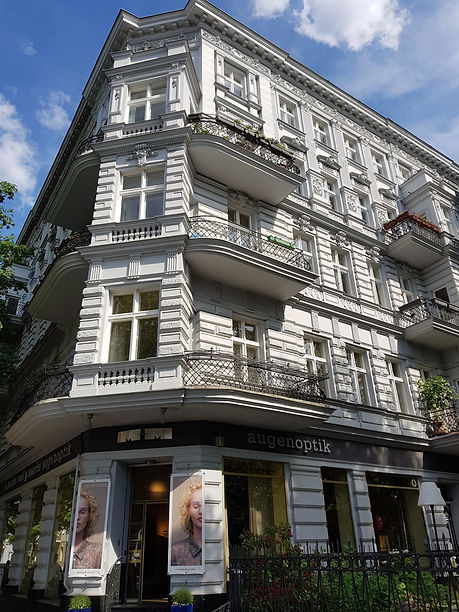









1989

THE TURN OF THE TIME
I remember the frighteningly beautiful emptiness of Potsdamer Platz, full of sadness also the Sunday football in front of the Reichstag. My last discussion of the anti-fascist protective wall took place in 2009 - on the occasion of an invitation to the Brecht House to discuss the twentieth anniversary of its collapse.
"How did you personally feel about the fall of the Berlin Wall back then?"
"As a shock," I replied spontaneously. The gentleman with a GDR background jumped up and was loud: "How can you be shocked by such a wonderful event?" His outrage was all around contagious, my bumpy explanations about subculture and underground increased the need for justification. It didn't look good for me and the misunderstood West Berlin alternative scene. Until - which I would not have thought possible - a sentence from Sven Regener's novel "Herr Lehmann" saved us, which an older listener from Bremen quoted: "The wall has fallen - oh, you shit." Big laughter in the hall, all right.
We were shocked. When the first concrete segment hung on the construction crane, we knew that our Berlin idyll and the alternative West scene would be lost, the usual attitude towards life, the flair in the bucket, out, over, terrible.
Gone for the scene mentioned here for the sake of simplicity, which since the 1960s had a decisive influence on the western sectors of Halbstadt as an invigorating element. After the building of the Wall at the latest, tens of thousands of Berliners interested in civil careers had left their amputated hometown; Less interested newcomers took their place - greeted with cardboard signs, 6 room apartment available, Pariser Strasse, 150 marks a month. West Berlin promised more than ruin chic and good fortune in taxes, the change of location alone had the character of a confession. Going to Berlin meant taking the royal route of the unadjusted ... and escaping the western hinterland, the parents, the barras, the philistinism.
taz, August 2011

1990
Mein Reisepass


My passport
February 1990 - The wall had just been open for three months and the eight previous border crossings (Friedrichstrasse, Heinrich-Heine-Allee, etc.) were no longer sufficient for all the people who switched back and forth between the two parts of the city. So additional, provisional border stations were set up, which existed until the official reunification. The first of these were: Invalidenstrasse, Brandenburg Gate, Rosenthaler Platz, Potsdamer Platz, Jannowitzbrücke, etc.
From February to April I passed the Iron Curtain every day when I was doing an internship in West Berlin and living in East Berlin. Shared accommodation in West Berlin was excessive for my young financial situation at the time and that gave me the idea of looking for an apartment in East Berlin. I found them on Ackerstrasse in the Mitte district.
West Germans needed a passport to enter the East. Since stamps were stamped on this document at the border between East and West, it filled up more and more with these documents from the temporary border crossings and thus became a special document.
The three months have been impressive. I lived in a house belonging to the East Berlin squatter scene. Yes, there was actually such a thing. Young people from the east German province came to Berlin, occupied houses, were punished for it, paid a small fine and then received a lease from the municipal housing administration.
The house in which I lived was full of young people who had come to Berlin from Stralsund, Greifswald or other cities. These city names were like from another world for me: Stralsund, Potsdam, Leipzig ... what did I know about them? It was foreign and far away and yet of course one had heard all these names - a foreign country and yet Germany. The young roommates in the house worked as a set designer at the Maxim-Gorki-Theater, as a bookseller at Unter den Linden, one was a landscape architect and had a hairstyle like Rainer Langhans from Kommune 1.
My apartment was heated with a tiled stove, and I still had to learn to fry with briquettes. In the kitchen it was warm from a radiator that had been removed from an S-Bahn. The toilet was halfway up the stairs and really cold in winter. The smell of briquettes was the smell of Berlin. It has now disappeared and very rarely, really only very rarely do I notice it in winter and wonder where it suddenly comes from and then all the memories are there again.
In the evening it was quiet in the apartment, Ackerstrasse was a cul-de-sac that led directly to the wall, no one went there who didn't belong there. Opposite the house was the Sophiengemeinde cemetery. The GDR street lights threw their orange light on the cobblestones and a seemingly lost Trabant of the People's Police drove its last patrol with a crackling two-stroke engine.
In the morning I listened to the GDR radio at breakfast. Peaceful music, calming. A nice start to the day. Later at the Pappelplatz tram stop I recognized the same people who, like me, were standing there every morning and waiting for the train - a young father with his small child, a few working people. Everyday life in a socialist country, as one could not even imagine after years of portrayals of the East in western media. I liked this morning waiting, when the street lamp, moving in the wind, threw its light on the bricks of the fire wall on the opposite side of the house, when the tram came with its screeching sound, when people went to work in this strange country.
I also liked walking home in the afternoon from the Friedrichstrasse train station through the city, either along Friedrichstrasse or past the Bode Museum, the Monbijoupark towards the Sophienkirche in Große Hamburger Strasse. Mountains of briquettes lay on the street in front of the houses. I remember a picture of a pick-up truck from the GDR brand Robur standing at a traffic light on Friedrichstrasse. On the back of the truck, lying on a pile of briquettes, was a rather dirty, muscular, young man who looked self-confident and demanding with a slightly mocking grin, while the rain-gray sky dripped lightly on him.
If you wanted to meet in East Berlin, you didn't do it by phone, instead a small pad with a pencil on a ribbon hung on each door of the apartment. A kind of GDR-style answering machine. The news was short and sweet: "Tonight there is a party in Friedrichshain, I'll come by at six, if you feel like you can come with me." We celebrated Women's Day, to which men were also invited, or went to a rally of the New Forum in the Gethsemane Church, where Wolf Biermann appeared. The nights in East Berlin were lively, the trams ran all night, we used them often, we were pretty tipsy every time we went home from the beer, which was incredibly cheap, some young people on the train played their guitars and sang . We explored the East Berlin theater world and saw "The Transitional Society" in the Maxim Gorki Theater and "Gorbatschow / Fragment" in the Volksbühne.
We came home one evening and suddenly heard the thunder of fireworks. For a brief moment, for fun, we suspected that it wasn't fireworks at all, but that the Russians had started to suppress the peaceful revolution with arms because the collapse of the East was going too far for them. In those days anything would have been possible.
We spontaneously decided to go to the roof of the house, where a worn, rickety iron rung ladder led through a skylight at the top of the stairwell. Then we finally stood over the roofs of Berlin and looked across the city at the fireworks in the west. We were silent and while a light, mild wind was blowing in our faces, I felt the whole expanse of the Mark Brandenburg, the plain on which this city lies, the entire attitude towards life of this city flowing through me.
It was a time that now runs in my memory like a film - a memory of a Berlin that has completely disappeared.

Berlin je t'aime
Patrick Suel believes in the spirit of cities. And a good spirit lives in Berlin. He feels that when he stands on the doorsteps of the Zadig and his gaze wanders along the Linienstraße. In autumn he will organize a "Repas de quartier citoyens", a "neighborhood picnic", to celebrate the fourth birthday of the French bookstore that he has built on Oranienburger Strasse. In a neighborhood teeming with people day and night. The neighbors will be sitting at long wooden tables in the street. Everyone will bring something to eat. Life in Berlin is velvety soft.
Régis Président-Girot also finds a quality of life here that was previously unknown to him. "In Berlin you can go to the opera by bike, you can walk around with your hiking backpack without being mistaken for a provincial." With bare feet and a three-day beard, he welcomes visitors to his chaotic office next to the water tower, this mighty, round brick building in the Prenzlauer Berg district. He smokes East German cigarettes, brand Cabinet. The stamp of the club he stayed at last night can still be seen on his hand. Through the large open window of his apartment, he looks at an old stone factory on Straßburger Strasse. Inside, around ten young French people jingle their laptop keys. Last year, Régis Président-Girot founded the "Gazette de Berlin", the only francophone bimonthly newspaper between the Alps and the Baltic Sea. A small newspaper intended for the French community. It is available in many Berlin cafés. "Berlin is a Disneyland for adults," he says
by: Pascale Hugues
THE TIME
Berlin Special 2007





